- A brief introduction to Chanderi Fort and what
to see including Jauhar Smarak and Chanderi Sarees.
We stayed for just a night at Chanderi on
November 9. Of course my main focus was to meet Lala Ram, the Master Weaver and
buy sarees from him. Do read - Pranpur
Village, Chanderi. We didn't realise how historic the fort was! There are apparently several temples and other places to see in and around Chanderi. Probably we need a three day stay next time.
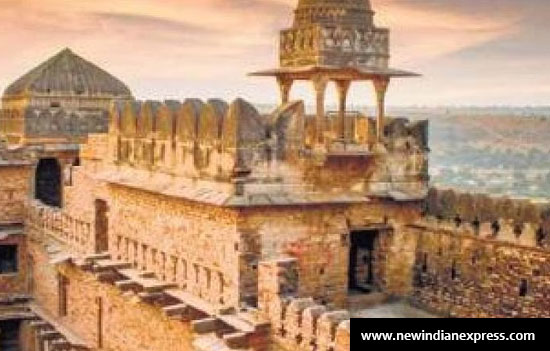 Chanderi Fort Complex.
Chanderi Fort Complex.
Hotel Kila Kothi - Fort
Bungalow
MP Tourism has a hotel right next to the
fort called Kila Kothi. It's a bungalow converted into a hotel. The hotel has large airy rooms beautifully appointed and maintained spotlessly clean. The Khansama makes absolutely amazing food and overall the service makes you feel good. Would highly recommend staying here.
As we had a very short distance to cover the
next day we decided to go for our morning walk to the Fort. Little did we know
that it was massive and historic! The entrance is very deceptive.
The Chanderi Fort was built in the 11th
century by Raja Kirti Pal. Several rulers subsequently conquered Chanderi -
Alauddin Khilji, Mughals, Bundela Kings and the Scindias. Currently the fort
belongs to the Scindia family.
Chanderi finds mention in Mahabharata as it was ruled by the Chedi dynasty. Shishupala, Bhagwan Krishna's cousin ruled over this place.
To add to the above Adya Parasher wrote
in Outlook India, “We made our way to the sprawling Chanderi Fort complex called the Kirti Durg. Perched on a hilltop, it offers breath taking views of
Chanderi and its surrounding forests and fields. The fort is also an
amalgamation of the different cultural and architectural elements that each
conqueror brought with them. There is the Naukhanda
Mahal with a central courtyard, fountain, and tank, which was built
by the Bundela king, Durjan Singh, in the 16th century. Also present is a mosque with intricate stone carvings featuring floral patterns and verses from the Quran built by Alauddin Khilji”.
There are a few buildings inside the fort
complex, including a palace, a mosque, Jauhar
Smarak and the Samadhi of Baiju Bawra,
the legendary singer.
Nanditta Chibber wrote
in New Indian Express, “The time-warped mofussil town in Madhya Pradesh played a tragic part in
history as the site of Jauhar-mass
self-immolation by about 1,500 women and children who chose to die than being
taken hostage by the armies of Babur in 1527. Their
story is inscribed on the premises of the Chanderi Fort, where the tragedy took
place. Babur had heard of the prosperity of Chanderi and wanted to seize it
from its Rajput ruler, King Medina Rai. The Jauhar
Smarak, a tall stone monument inside the fort, stands like a lonesome
sentinel.
After the battle, Hathi Darwaza-the entrance for
kings on elephants-was renamed Khooni Dawarza, because soldiers were thrown
down from the battlements, their blood soaking the ground”.
As soon as you walk in you find the Jauhar Smarak on your left, then the samadhi of Baiju Bawra. A little further there is a direction board that says "khooni darwaza".
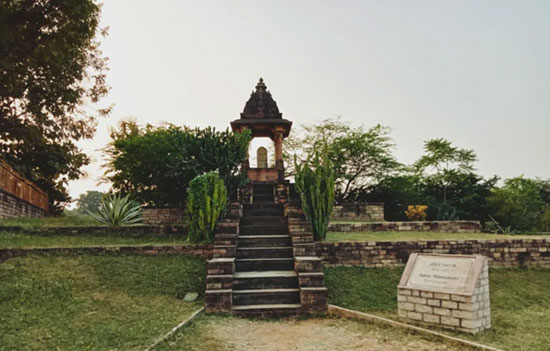 Jauhar Smarak.
Jauhar Smarak.
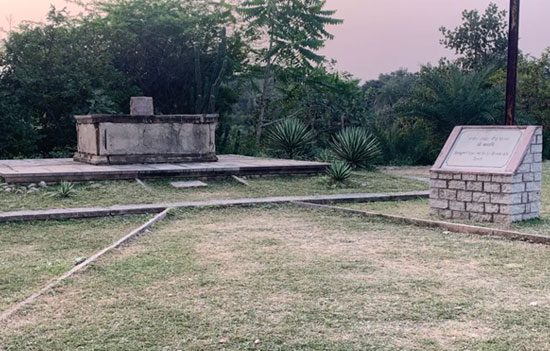 Baiju Bawra tomb.
Baiju Bawra tomb.
If you follow the
way to Khooni Darwaza you come to a massive gate. Convicts were thrown off the
top of the door and obviously they died as the path from the fort and the walls
are all made of stones.
When we walked in there was nobody around.
As we went to the ramparts of the fort, a gentleman was meditating and then he
did some yoga before leaving the area. As you take the stone hewn path in front
of the khooni darwaza you come upon the mosque and the palace on your right and
the ramparts right in front of you. The rampart walls are wide and we could
walk across and see the Chanderi town below.
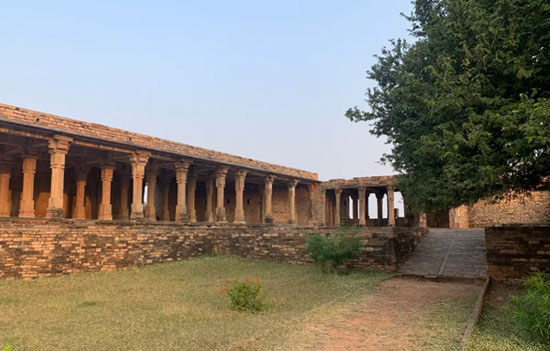 Khilji Masjid.
Khilji Masjid.
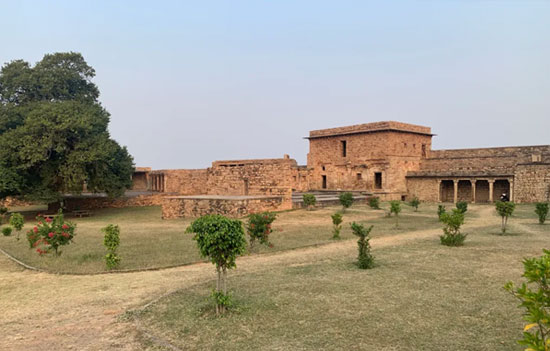 Part of Kirti Durg Fort.
Part of Kirti Durg Fort.
Do visit Chanderi
Museum. Nanditta C tells wrote in same article about what is on display, “Rare and exquisitely carved stone sculptures and relics excavated from Budhi Chanderi, dating back to the 10th century. Surveying them is like taking a crash course in Hindu mythology and Jainism; there are rare statues of Tirthankars, a four-armed Gaja Laxmi, an eight-armed Shiva and a gallery dedicated to Vishnu’s incarnations such as Vamana (human), and Matsya (fish)”.
We certainly intend to spend a couple of
days in Chanderi next time to take in the sights. 50 kms from Chanderi is Kadwaya village that dates the 8th
century. It has 15 Hindu temples, a fort and tanks from the 8th
century. The grandest of them all is Toteshwar
Mahadev, a temple where worship is alive.
India has so many places that modern India
has forgotten or not caught popular imagination like Kadwaya. I hope to visit
next time.
Chanderi is a beautiful historic place and
the weaving done here traces its roots back to the Mahabharata period. Do visit
and buy handloom sarees from here besides
visiting the tourist spots.
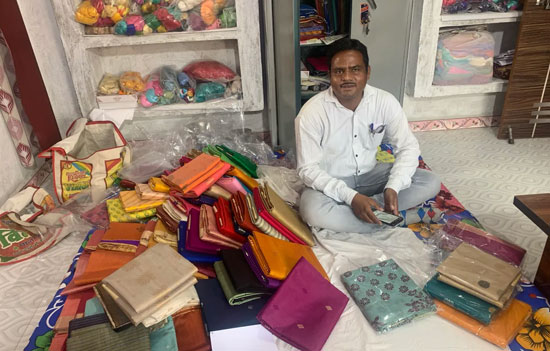 Lala Ram Koli at his shop.
Lala Ram Koli at his shop. How
to reach Chanderi
It is about a 7
hour drive from Indore, 4 hours from Gwalior and 2 hours from Jhansi. By train
get off at Lalitpur Junction i.e. 36 kms from Chanderi. Jhansi is well
connected by train to Mumbai and Delhi. One way is to get off at Jhansi and
hire a vehicle.
A video shot from the ramparts of the fort
To read all
articles by author
Author is an an Executive Coach, Co-founder www.Shikshadaan.com and blogs at www.90rollsroyces.com Except where mentioned article pictures by author.
Also
read
1. Chanderi
Saris and their rich history
2. How
to differentiate and identify Chanderi and Maheshwari sarees